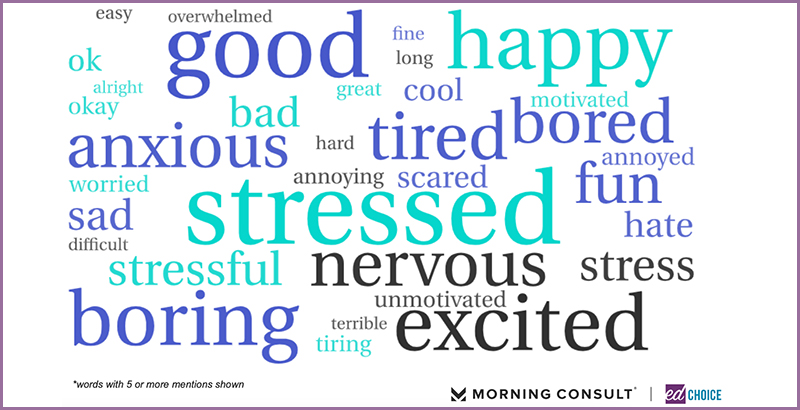Analysis: Tutoring, Mentoring & Personalized Learning — How to Help Students Reconnect to Teachers, Peers and Give Them the Social-Emotional Support They Need

Get stories like this delivered straight to your inbox. Sign up for The 74 Newsletter
Even before the COVID-19 pandemic, survey after survey showed teens in the United States were facing high, rising levels of stress and anxiety. The alarm now rings loudly for us to wake up to their situation.
The pandemic has only exacerbated the challenges for youths in America. September polling from EdChoice and Morning Consult shows that teens still report negative impacts of the pandemic on their mental health and overall well-being, with 55 percent saying their stress is worse than it was pre-pandemic.
In a Washington Post-Ipsos poll, teens report the pandemic has caused major setbacks for their mental health, friendships and academics. But they are three times as likely to say the pandemic has had a positive impact on their relationship with their parents than a negative one.
Schooling in the last 18 months has been tumultuous, to say the least. Students had to adjust to remote learning on the fly, saw extracurriculars and athletics halted or hindered, and stood by as adults argued over school closings, reopenings and mandates for masking or vaccinating. As most students are back to learning in person, education policymakers and leaders, community groups, charitable and faith-based organizations and foundations must start helping them heal and thrive.
Many teens need to move from shock, fear and confusion to hope, energy and enthusiasm. That will require significant support. They need help to avoid a self-perpetuating spin cycle of frustration, sadness and stress — feelings that have increased since last year. To that end, young people urgently need a strengthened sense of purpose and revitalized social connections.
Those connections, according to a survey by America’s Promise Alliance and Grad Nation, are particularly weak right now. “Youth report feeling most connected to their teachers (47 percent felt somewhat connected or very connected), followed by classmates (41 percent) and peers in their communities (39 percent), however, the majority of students still indicated feeling only a little or somewhat connected within these relationships,” the survey report authors say. In YouthTruth’s spring survey, 49 percent of teens reported feeling depressed, stressed, or anxious — more than during the previous fall.
There are two important ways to support teens during this critical reconnection phase as we come out of the pandemic.
First, rapidly expand access to tutoring and mentoring programs that can foster personal fulfillment and encourage social interactions, as well as help younger children recover from COVID-related learning loss.
There’s no need to reinvent the wheel. Policymakers in the public sector and social entrepreneurs in the private sector should take a hard look at schools and districts with robust tutoring and mentoring programs. New initiatives at Johns Hopkins University and Brown University provide evidence-based resources for learning the who, what, how and why of effective tutoring in schools. Saga Education and Match Education demonstrate the value of high-dosage tutoring. The Tennessee Tutoring Corps shows how policymaking can bolster teens’ connections, learning and wellness through tutoring and mentoring. And longstanding mentoring programs, such as Big Brothers, Big Sisters, Boys & Girls Clubs and Best Buddies, are standing by to engage and mobilize.
Second, continue to pursue K-12 policy frameworks at the state level that gives families and older students more personalized learning options.
Teens want more flexibility and say in where and how they learn. Our recent polling shows they are nearly evenly split between wanting full-time regular classes and some form of hybrid model, where they can learn for part of the week at school and part from home. Pandemic pods also have ongoing appeal, both as a stand-alone form of schooling and as a supplement to classroom learning.
Teens also want to be involved in choosing their schools. Nine out of ten in the survey said they wanted at least some of that responsibility. They and their families can — and should — be afforded more control over their schooling preferences through new or expanded hybrid homeschooling, microschools and pods.
The global pandemic has spanned three school years. Students who were in seventh grade in March 2020 are now in the second quarter of their freshman year of high school. During these critical years, they likely have experienced turmoil, uncertainty, disruptions and bouts of isolation. It should come as no surprise that they want a say in their future, given all they have endured.
This is no time to follow paths of least resistance and do what is comfortable. We are all living together in uncomfortable times. The country’s youth will be looking for innovative supports and opportunities — mental, social and educational — to ensure their future growth, success and contributions to society.
Paul DiPerna is vice president of research and innovation at EdChoice.
Get stories like these delivered straight to your inbox. Sign up for The 74 Newsletter

;)